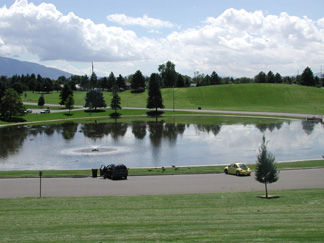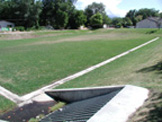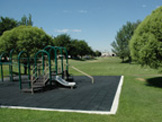SLC Stormwater Detention Basins Provide Multiple Benefits
Urban open space and recreational benefits are added benefits of flood control facilities.
August 16, 2005
|
The operation of these basins are such that they store water during peak flow periods, and once the storm run-off has subsided, the stored stormwater is slowly released back into the stormdrain system to flow to the Jordan River. Detention basins allow the construction of smaller stormdrain systems and prevent flooding episodes by controlling peak flows.
Although the primary purpose of detention basins is for flood control, these basins also provide both open space and recreational amenities for the community. Many of the basins are landscaped and attractive. Under normal conditions these basins are dry, which allows large play areas for recreational activities. Many have play ground equipment installed for children to enjoy. In an urbanized setting, detention basins provide the community additional open space to relieve the visual sight of structures that make up the cityscape. Landscaped detention basins provide a quite place to play, read a book or take a nap.
Two very visible detention basins are located in popular public parks. Liberty Park and Sugar House Park both contain critical detention facilities that regulate the storm event run-off from the east bench of the city as well as flowing streams from Red Butte, Emigration and Parley’s canyons. Paddle boats can be seen navigating over the surface of the Liberty Park pond and park visitors enjoying the view of various species of birds, which frequent the Sugar House Park pond. Most park visitors probably don't even know that these water bodies are flood control facilities.
Sugar House and Liberty Park detention basins play a critical role in managing spring snowmelt from the canyon watersheds and rain runoff generated along the east bench. This past spring water flows through Sugar House Park reached 200 cubic feet per second. Fortunately, there were only moderate storm events during the peak run-off period, making it unnecessary this year to close the flood control gate, which would have inundated the areas surrounding the detention pond. However, in past years there have been large storm events that have made it necessary to flood the lower elevations of the park and block vehicular traffic.
Most of the stormwater detention basins are located off-stream and collect only rain event run-off from the City’s various localized drainage basins.
The detention basins located in Salt Lake City are joint facilities, with partnerships between Salt Lake City Department of Public Utilities, Salt Lake City Parks Department and Salt Lake County Flood Control.
So, if you see a patch of open space with a berm around it, it’s probably one the many detention basins scattered around Salt Lake City that help prevent flooding during heavy rain events and spring run-off.


